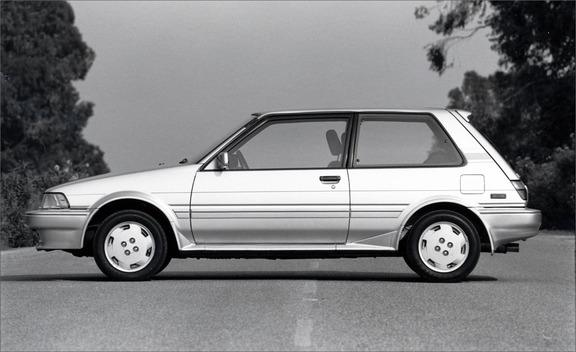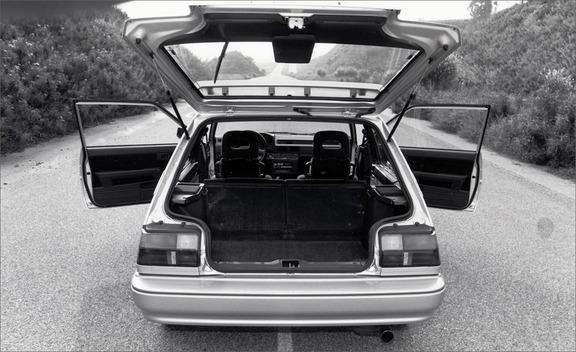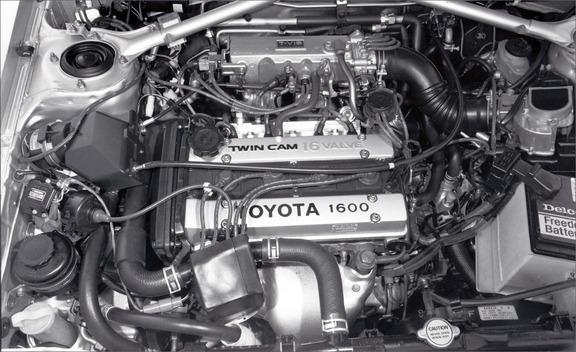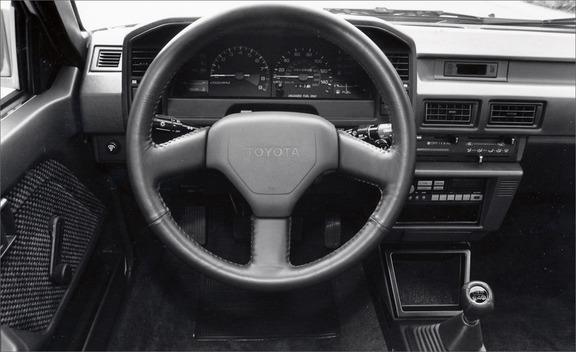 Archived Road Test
Archived Road Test
There was a time when engines with fuel injection, double overhead cams, and four valves per cylinder could be found only in breathlessly expensive cars built in tiny volumes by manufacturers most car people worshiped as gods. When GM tried to mass-produce such technology, the experiment ended in dismal failure. The General went off to lick its wounds and forced American car owners to do penance by selling them tired old four-bangers (Iron Dukes) that should have been retired when spats went out of vogue.
It doesn't do our national pride much good to know that it took Toyota to mass-produce a truly sophisticated engine and to get it right the first time. What we're talking about, of course, is the 4A-GE four-valve, twin-cam four-cylinder. This 1.6-1iter high-revver made its first U.S. appearance in late 1984 in the rear-drive Corolla GT-S, then reappeared a few months later in the mid-engined MR2. Now the same powerplant has found a home in the engine bay of the front-drive Corolla FX16, a car that defines the term "pocket rocket."The amazing thing about all this is that Toyota is pretty casual about the introduction of these various models. Most carmakers would shuffle around and give you a million reasons why it would be impossible to transplant a four-valve head onto any particular engine or to put a four-valve engine into another chassis. They'd bring up market studies, cost considerations, engineering problems, and the big-time equivalents of "My dog ate my homework." Even VW found the four-valve route paved with technological boulders and delayed the introduction of its four-valve engine more than two years. Toyota, on the other hand, seems to be run by a bunch of gonzo back-yard tinkerers who happen to have all the money and engineering resources in the world to pull off any kind of car that strikes their fancy. You can imagine these guys bench-racing over Sapporo beers and asking one another, "Hey, wouldn't it be neat to . . . ?" And then they go ahead and do it.
The FX16 treatment seems to be the product of such a session. It doesn't exactly make for the kind of car that will stop your heart or have a great impact on the evolution of the automobile. It just happens to be a neat thing to do to a hatchback—the kind of thing a good aftermarket guy would do if he had CAD/CAM equipment and an assembly plant at his disposal.

Fortunately for us, Toyota does have CAD/CAM and an assembly plant. The factory in this instance is the new NUMMI facility in Fremont, California, the same place where GM and Toyota jointly assemble the Chevrolet Nova. Although Novas and FX16s will be rolling out of the same building, Toyota emphatically states that the FX16 will be strictly a Toyota model; it will not be sold in Chevy dealerships. It will go on sale this September and will be offered in but one body style: a three-door hatchback that is halfway between a feisty fastback and an everyday econobox in shape. Two trim levels will be available: base and GT-S. The NUMMI plant is programmed to produce a total of 13,000 FX 16s by the end of this year; in 1987, the total FX 16 production should be around 37,000. Obviously, this isn't a high-volume car for Toyota, but it is an excellent end run around the voluntary quota system, which limits the number of cars Toyota can import from Japan.
The heart and soul of the FX16 is its motor. The 1.6-liter, twin-cam, sixteen-valve, fuel-injected four-cylinder produces 108 horsepower at 6600 rpm. Interestingly, when this same engine is assigned to duty in the MR2 and the rear-drive GT-S, it produces 112 hp. Toyota attributes the modest power loss to a redesign of the four's intake and exhaust manifolds, which had to be modified to fit in this Corolla's engine compartment. Except for plumbing, however, the 4A-GE engine is unchanged. The redline remains at the blender-level 7500 rpm.
The gearbox is so slick, as we've come to expect from Toyota, that it feels as if it were machined from solid billets of Teflon. We wonder what kind of shift-mechanism secrets Toyota possesses that the rest of the car world can't seem to copy. The five-speed is further blessed with close-ratio gears, exploiting the engine's high-revving capabilities.

An automatic transmission is available as an option, but no FX16 so equipped was available during our brief test sessions with the new Toyotas. The automatic is an electronically controlled four-speed, with a lockup torque converter that engages in second, third, and fourth gears. It's also equipped with a button that changes the shift points on demand. In the meditation mode, the transmission upshifts at lower rpm, improving fuel economy; in the banzai mode, shifts occur at higher rpm, improving both your quarter-mile ET and your spirits.
The suspension has been substantially improved over any previous Corolla's. For starters, Toyota has abandoned the common nationalistic practice of specifying home-grown tires. Instead, the FX16 gets premium rubber in the form of Goodyear Eagle GTs: 175/70HR-13s for the base model and 185/60HR-14s for the GT-S. The shorter supply route from Akron to Fremont probably had some influence on decision. Even so, Eagles are far from cheap, even at the OEM price, and their use is indicative of Toyota’s serious intentions for the car.
The front suspension consists of strut units, stamped-steel control arms, and a 23mm anti-roll bar. The rear has struts, dual transverse links, trailing links for longitudinal location, and a 16mm anti-roll bar. A transverse brace is bolted across the top of the front strut towers to minimize chassis flex during heavy side loadings. A second brace is bolted longitudinally between the front-suspension cradle and the floorpan to limit cradle movement in the fore-and-aft direction. A third structural brace is bolted between the pivot points of the rear suspension's twin transverse links. Four-wheel disc brakes (vented at the front) and a power-assisted rack-and-pinion steering system complete the underbody hardware.
None of this is what you'd call supersophisticated. We're not talking Weissach axle, four-wheel steering, or ABS. Quite the contrary. The approach is simple, low-dollar, and straightforward, but eminently effective. Although the suspension is firm, for example, Toyota seems to have done a great job of canceling out all the noise, vibration, and harshness sometimes associated with "sport" suspensions.

Toyota designed the interior with the same straightforward approach, spending its money where it would do the most good. You won't find digital ashtrays or tufted radio knobs. What you will find is an excellent A-spoked steering wheel with an appropriately thick rim and, in the GT-S, a hand-stitched leather cover. An adjustable steering column is standard with either trim level. The standard driver's seat in the GT-S is adjustable for height as well as for rake, and the optional sport seat also features adjustable lumbar support and upper-back bolsters. Instrumentation includes a tach, a 140-mph speedo, and engine-temperature and fuel gauges. Idiot lights perform early-warning functions for low fuel, battery condition, and brake failure. You'll find a storage bin in each door, two smallish bins in the center console, and a fairly deep glove box. There is plenty of headroom for both front and rear occupants, but rear passengers with long legs will probably complain of inadequate kneeroom. Split, folding rear seats are standard equipment. While lacking the machined, technoid look of the GTI, the FX 16's main competitor, this interior is very livable and on a par with that of any other car in its class.
On the superslab as well, the FX 16 doesn't give up much to any of its nickel-rocket competition. It offers excellent directional stability, a good on-center feel, a comfortable ride, and decent bump absorption.
Like its 4A-GE–equipped stablemates, though, the FX 16 doesn't have much low-and midrange torque. The engine revs freely and easily, but nothing very spectacular starts happening until about 4700 rpm. A fast launch from a stop requires a merciless foot on the gas and a quick step off the clutch pedal.
On the narrow two-lane courage-verification roads of Southern California's Angeles Forest, the FX16 is either exhilarating or frustrating, depending on whether the road goes uphill or downhill. The car leans eagerly into a corner and provides a gradual increase of steering effort with increasing cornering loads. The Eagle GT tires stick impressively (they generate 0.77 g on the skidpad). In really tight corners, the dominant characteristic is pronounced understeer. You can cancel some of the front scrub by gently lifting off of the throttle or by trail-braking into turns, but we found it was much too easy to induce sharp oversteer by braking hard and long into a corner. In fact, the transition from under-steer to oversteer caused by overenthusiastic use of the brakes caught us by surprise the first few times. With a little stick time to learn the FX16's characteristics, though, it soon became easy to apply just the right amount of braking to get the car properly rotated for any given corner.

On steep uphill stretches, the FX16 cries out for more torque. In tight uphill corners, we found ourselves dropping down at least one gear lower than we normally would, and even that was more a holding action than a means of increasing momentum. Because of this lack of reserve power, the FX16 demands to be driven smoothly. If your line is a little ragged and you scrub off a lot of speed, it's hard to get it back for a quick exit.
In fast sweepers the car's behavior is excellent, telegraphing every twitch of its tail and giving the driver plenty of early warning to make all the right body moves and facial gestures of truly fast motoring.
Whatever the FX16 may lack in sheer horsepower, it compensates for handsomely in handling, in ride quality, and in overall fun-to-drive personality. In comparison with its competition, it has most of the bases covered. It's slightly quicker than the GTI to 60 mph, and the two are neck and neck at the end of the quarter-mile. It's slower by only 0.6 second to 60 mph than the Mitsubishi Mirage Turbo. Although the FX16's price hasn't been officially announced, we expect the base car to cost around $9000—roughly $600 cheaper than the GTI and about $800 more expensive than the Mirage Turbo. The upmarket GT-S should start at about $10,000.
There are a couple problems with the FX16. We'd love to see the engine produce more low-rpm torque, and the brake balance and modulation could be improved to shorten the stopping distance. But overall, the FX16 is a worthy achievement. If you're in the market for a moderately priced sporty hatchback, this car deserves your serious consideration.